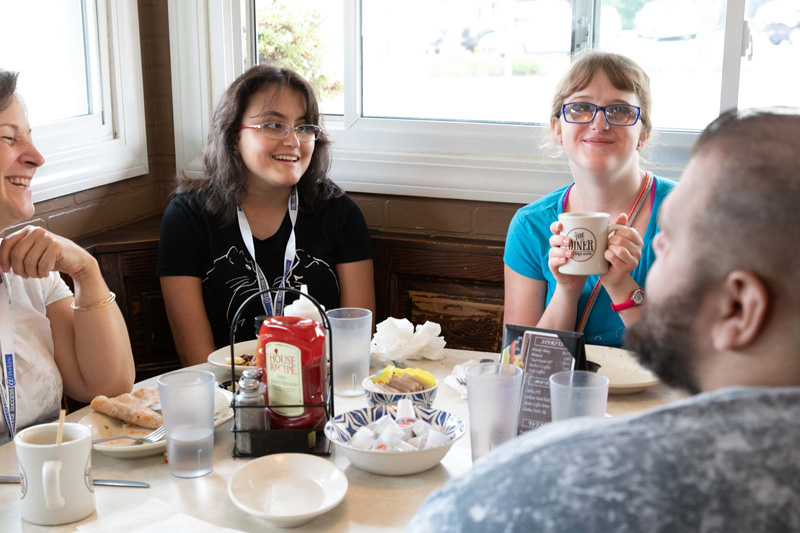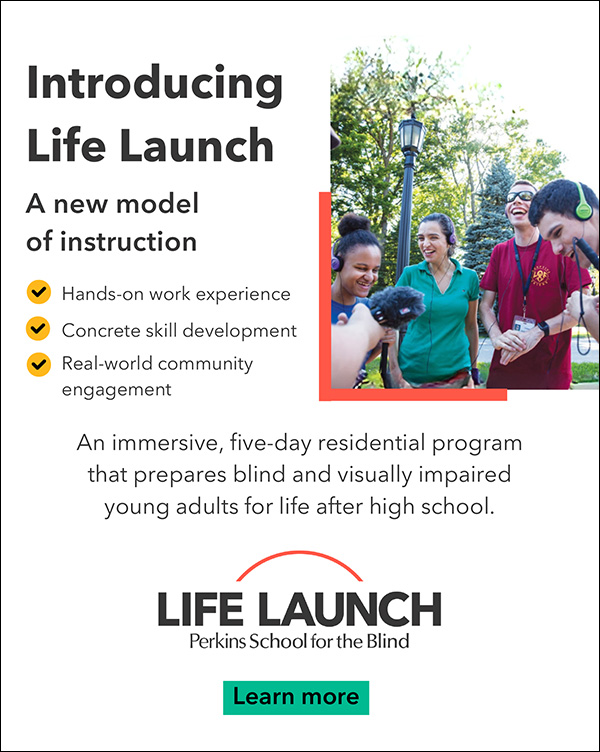The prevalence of autism has been increasing over the years. The CDC estimates that 1 out of every 44 children has an autism spectrum condition (CDC, 2021). It has changed from a low-incidence disability (i.e., 1 in 10,000) to a more common one. Blindness, on the other hand, is currently considered a low-incidence disability, only affecting about 1% of children and youth. This translates into an incidence of approximately 239,700 transition-age youth aged 16-20 years (Erickson, Lee, & von Schrader, 2019 as cited in Lund & Cmar, 2020). However, what is the co-occurrence of autism with blindness or low vision? Few parents and professionals know about autism and co-occurring low vision and blindness and one of the leading causes of blindness, Cerebral/Cortical Visual Impairment (CVI), let alone how to intervene.

A group of Perkins School for the Blind teenagers and adults enjoying lunch at a restaurant
What is Cerebral/Cortical Visual Impairment?
Cerebral/Cortical Visual Impairment (CVI) is a brain-based visual impairment caused by damage or interruption to the brain’s visual pathways or visual processing centers. It is currently the leading cause of blindness and low vision in children, yet CVI is alarmingly underdiagnosed (the CVI Center, 2023). Their white paper describes that CVI commonly occurs in neurodevelopmental disorders. The statistical model in the paper estimated that at least 180,449 individuals 0-22 years were diagnosed with CVI or likely to have CVI. From their sample, they were able to identify 24,269 patients with a CVI diagnosis and 155,980 likely to have CVI. This translated into a diagnosis rate of less than 14%. These numbers represent more severe cases of CVI, but CVI has a broad spectrum of experience, like autism. Therefore, the numbers are conservative and underestimated. One study out of the UK found that 1 in 30 primary school children may have CVI-related vision problems. The CVI Center concluded that for every child diagnosed with CVI, another 4 children are likely to have the disorder. This is similar to the early years of autism before the symptoms were more widely known.
What is the Overlap Between Autism and Co-Occurring Low Vision and Blindness?
Researchers have long suspected an overlap between visual impairment and even severe visual impairment (SVI) and autism since the late 1950s, which gained traction through a series of articles in the 1960s and 1970s (Molinaro et al., 2020). Some researchers contend that “…autism could currently be considered one of the most commonly reported co-existing developmental disorders in children with blindness or other severe visual impairment” (Petretto et al., 2023). The cause or origins of the blindness or visual impairment appear to correlate with the presence of autism.
There is a close relationship between ASD and SVI based on some specific etiology at the bottom of the severe visual impairment: there are less than 10 clinical conditions where this relationship is very close, ranging from 20/30% to 70% of comorbidity, such as retinopathy of prematurity, Leber’s amaurosis, optic nerve hypoplasia, septo-optic nerve dysplasia, micro-ophthalmia, an-ophthalmia and CHARGE syndrome (Petretto et al., 2023).
Molinaro (2020) reviewed research papers between 1958 and 2020 and identified 921 studies that examined the relationship between autism and co-occurring low vision and blindness. In these studies, autism is the most common co-occurring condition within the visually impaired population, and the etiology (cause) of the VI made a significant difference in the prevalence of ASD behaviors or symptoms. One study found that 33% of children with septo-optic dysplasia (SOD) and optic nerve hypoplasia (ONH) received a clinical diagnosis of ASD. In a Swedish study with a sample of children born with blindness, ASD was the most common co-occurring condition, with 38% of this population having an ASD diagnosis. The study went further to specify that the prevalence of ASD was higher in children with ONH (70%), in children with retinopathy of prematurity (ROP) (58%), in children with microphthalmia/anophthalmia (44%), and in children with Leber’s congenital amaurosis (LCA) (36%) (Molinaro et al., 2020).
CVI is often misdiagnosed as autism because of overlapping behaviors or symptoms. CVI and ASD do co-exist, but CVI is often missed or not diagnosed until later. The implication here is that pediatricians, ophthalmologists, and neurologists working with children with autism should be trained in recognizing CVI and be able to conduct a differential diagnosis. Consequently, practitioners must be able to complete a differential diagnosis using assessment tools such as the ADOS that have been modified to not rely upon sight-related behaviors. For parents, the implication is that if they have a child with BVI, they should select a medical provider who can assess for ASD in children with blindness and low vision.
Educational Interventions for Students with Both Visual Impairment and Autism
Few school districts have enough students to create programs for educating students with VI. There is no economy of scale. When faced with a student with both VI and ASD, the school districts lack the expertise to educate the student. Under IDEA, students are entitled to a Free and Appropriate Public Education (FAPE). Suppose the school district cannot meet the student’s educational needs. In that case, an option under IDEA is that they may educate the student in placement out of the school district at a private school that specializes in educating youth with VI.
Perkins School for the Blind in Watertown, MA, has been educating students with autism and co-occurring low vision and blindness and other visual impairments for almost 200 years. It is a leader in blindness education and educating students with multiple complex issues. Perkins has trained educators working in over 95 countries around the globe, creating a world of inclusion, accessibility, and opportunity for people with multiple disabilities. The Perkins School for the Blind is a thought leader through its CVI Center, Transition Center, and other offerings. It conducts research and is developing a knowledge base of empirically-based practices to educate students with CVI.
A New Model of Educating Students with Autism and Co-Occurring Low Vision and Blindness and Other Co-Occurring Conditions
In recognition of the complexity of preparing students with BVI for the world of work and independent living, Perkins recently announced its Life Launch Program. The Life Launch Program is Perkins’ latest offering, targeting transition-aged youth looking to enter the world of work and independent living. This work-based, residential transition program is designed for students who have diagnosed autism and co-occurring low vision and blindness or visually impaired, with multiple disabilities (including autism), and who have goals of finding meaningful work and community participation after high school. The program recognizes that students with BVI are employed at lower rates than their non-disabled peers. To prepare these students to meet the challenges of employment and independent living, the Life Launch curriculum features specialized instruction, intensive transition planning, and individualized experiential learning.
The Life Launch Program will begin accepting applications in January 2024 and will welcome the first class of students to campus in the Fall of 2024. For more information, visit www.perkins.org/transition-center/life-launch.
Perkins also offers a range of impactful programming and resources designed to assist more academically oriented students with BVI to transition to post-secondary higher education programs, including colleges, universities, and Comprehensive Transition and Post-secondary (CTP) programs. For more information on these programs and resources, visit www.perkins.org/college-success.
Ernst VanBergeijk, PhD, MSW, is the Founder and President of Ernst Equitable Education Solutions, a consulting firm that helps parents find appropriate educational settings and solutions for their children and helps organizations evaluate and design programming for special needs children, youth, and young adults. He has over 35 years of experience in the special education field, including working as the executive director/dean of two college-based transition programs for students with various disabilities.
Alexandra LaVoie, MSOT, is the Director of the Transition Center at the Perkins School for the Blind and is a licensed occupational therapist and special education administrator. Alex has worked in the field of blindness education for over ten years and has a deep understanding of the unique supports and accommodations that are needed for BVI students to achieve their post-secondary goals. She is passionate about Perkins’ mission to empower students with disabilities to unlock their potential and live as independently as possible.
References
Center for Disease Control and Prevention. (2021). Prevalence and characteristics of autism spectrum disorder among children 8 years – autism and developmental disabilities monitoring network, 11 sites, United States, 2018. Morbidity and Mortality Weekly Report, 70(11), 1–16.
Cortical/Cerebral Visual Impairment (CVI) Center. Perkins School for the Blind. (2023). The current state of CVI: A hidden epidemic. Watertown, MA. https://www.perkins.org/wp-content/uploads/2023/09/CVI_Whitepaper_FINAL.pdf
Lund, E.M., and Cmar, J.L. (2020). A Systematic Review of Factors Related to Employment in Transition-age Youth with Visual Impairments. Rehabilitation Psychology, 65(2): 122-136. https://www.blind.msstate.edu/sites/www.blind.msstate.edu/files/2020-04/transitionsystematic.docx
Molinaro, A., Micheletti, S. Rossi, A., Gitti, F., Galli, J., Merabet, L.B., and Fazzi, E.M. (2020). Autistic-like features in visually impaired children: A review of Literature and directions for future research. Brain Science, 10(8):507. doi: 10.3390/brainsci10080507
Petretto, D.R., Lucrarelli, L., Farris, P., Penna, V., Valinotti, S., Pietro, C.G., Gaviano, L., Berti, R., Pili, L., Zolo, B. and Pili, R. (2023). Children with autism spectrum disorders and severe visual impairments: Some general principles for intervention according to the perspective of clinical psychology of disability. Journal of Public Health Research; 12(2):22799036231166314. doi: 10.1177/22799036231166314.
The CVI Center (2023). The current state of CVI: A hidden epidemic. Perkins School for the Blind. Watertown, MA.








